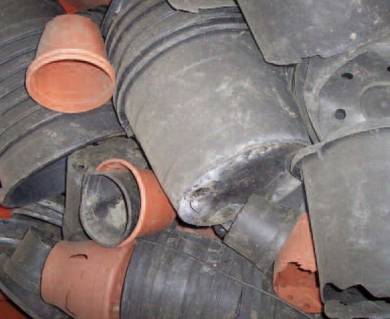
It is tempting to let go of our Green Fingers and immediately opt for cheap plastic pots, recycled or not. But in the horticultural sector, the plastic waste mountain is huge. What are the alternatives. Are they feasible? What if we try something different? Do you have tips? Bring it on.
Here you will find some useful links.
This post is unfortunately in English. But the translation will follow soon. Let yourself be inspired not to use plastic. How do you handle it then?
Translated with Deepl.
The first alternative I discovered for people who tend to use plastic in the garden to display plants or flowers. But I was sent these, which are bamboo fiber composites. They come in a whole host of crazy colors. But it is said that if they end up in the dump, they will photodegrade without a trace within five years. So if you have a balcony or patio and you use plastic to put plants in, these are a good alternative. They don’t really solve the problem of flat plastic pots. So I’ll move on to other alternatives how to get your plants without the need for blockbuster. So what about people who want to buy pounds without plastic, edible culture UK who are based in the south have come up with a really ingenious idea. And it’s this the positive parts now they’ve completely made this themselves as a recyclable card. And when you see that little Molly stick that holds the partners together, there’s no glue or adhesive. They write the name of the plant on the stick, which is also biodegradable. If you buy the plants from them, they put a layer of mycorrhiza fungi in the soil. All that cutie does is build a relationship between the roots and the fungi that exchange moisture for sugar. So basically, kickstart plants and make sure they have the best start in life. What you do with this is, you take them home and literally plant them out. Don’t do anything in a few weeks, this popular softer biodegrade, fall apart, the Phone Guy does its job and it fixes it’s cheap, it’s cheerful, and I think it’s a brilliant idea.
So the next innovative example comes from Bluebell cottage nursery here in the North West of England. The owner has been in favor of moving away from plastic for some time, and she has devised a solution for her customers that also eliminates the need for plastic parts. If you buy a pump from her, you can have it transferred at the point of sale into a biodegradable container or paper bag, which you can take home right away. What Sue is doing now is cleaning and recycling those black plastic parts by propagating more plants, ready for next year. If you order from her, she will deliver them in a cardboard box wrapped in waxed paper with biodegradable labels for the pump’s name. Plastic labels, name labels or other plastic pump parts are therefore no longer necessary and that is a great idea. What has really struck me is how much plastic I use as a garden designer. And just looking back at the past year and the amount of pump pots I’ve used, it’s disturbing. Now lucky for me, I have to take a load to a recycling center that does recycle them. But it was a long way off. And I know a lot of you say, we can find those centers, but they’re miles away. And there’s a tradeoff between the pallets of carbon you put in your family, your car to get them there and try to recycle them. And it’s a terrible dilemma, that’s what has led me to try and find alternatives, because there’s no way we can just continue flushing a sea of plastic. So I know I’ve only just surfaced on what to do about the white plastic recycling problem. I’ve talked to a number of manufacturers, wholesalers and independent nurseries, some of which are very eager to talk to me, or not so many, but I know there are many more ideas out there. And I think it’s about keeping the debate going and opening people’s eyes to alternatives. So what I’m going to do is ask you, the viewer to help me, we need to get the message out about alternatives, because we can’t keep drowning in the sea of plastic. So if you have any ideas or know of any businesses or daycares that do things differently, leave a comment below. Get in touch via Twitter. Follow my blog and add comments. Let’s try to compile a list of all the alternatives and see what we can do to the customers to make these alternatives obsolete. So if you’ve liked this video, or feel strongly about the topic of recycling please subscribe to my YouTube channel, share this video and let’s keep the debate going.
Translated with www.DeepL.com/Translator